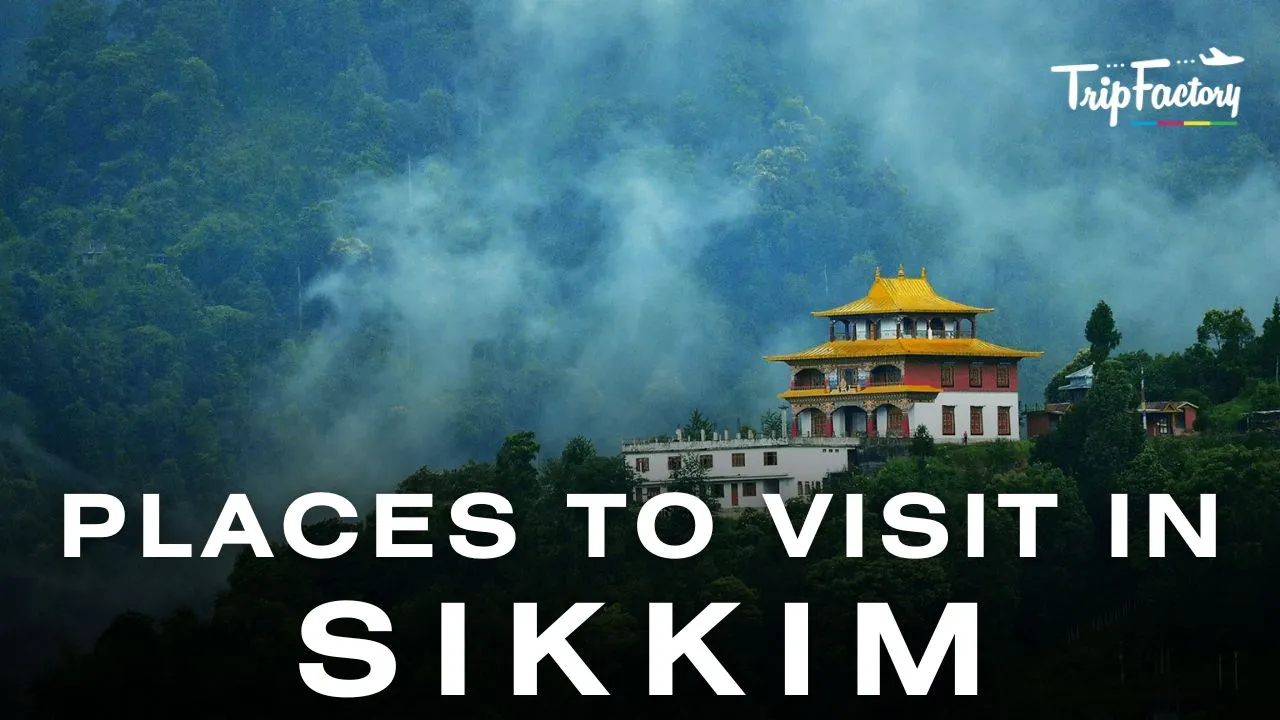Sikkim is located near the Himalayas and offers a treasure trove of vibrant traditions and cultures, exotic landscapes, and captivating experiences. People from different parts of India visit this destination to attain an unforgettable experience for adventure seekers, cultural enthusiasts, and nature lovers.
Sikkim lies on the border of West Bengal, Nepal, Bhutan, and China. It is also the gateway to the Northeastern corridor of India that offers a list of things to do amidst the nature and majestic Himalayas. Sikkim is also located near Kanchenjunga, which is the third-highest peak in the world. If you are planning to visit Sikkim, you must visit some of the iconic places in Sikkim to attain remarkable experiences.
Table of Contents
Best Places to Visit in Sikkim
Gangtok
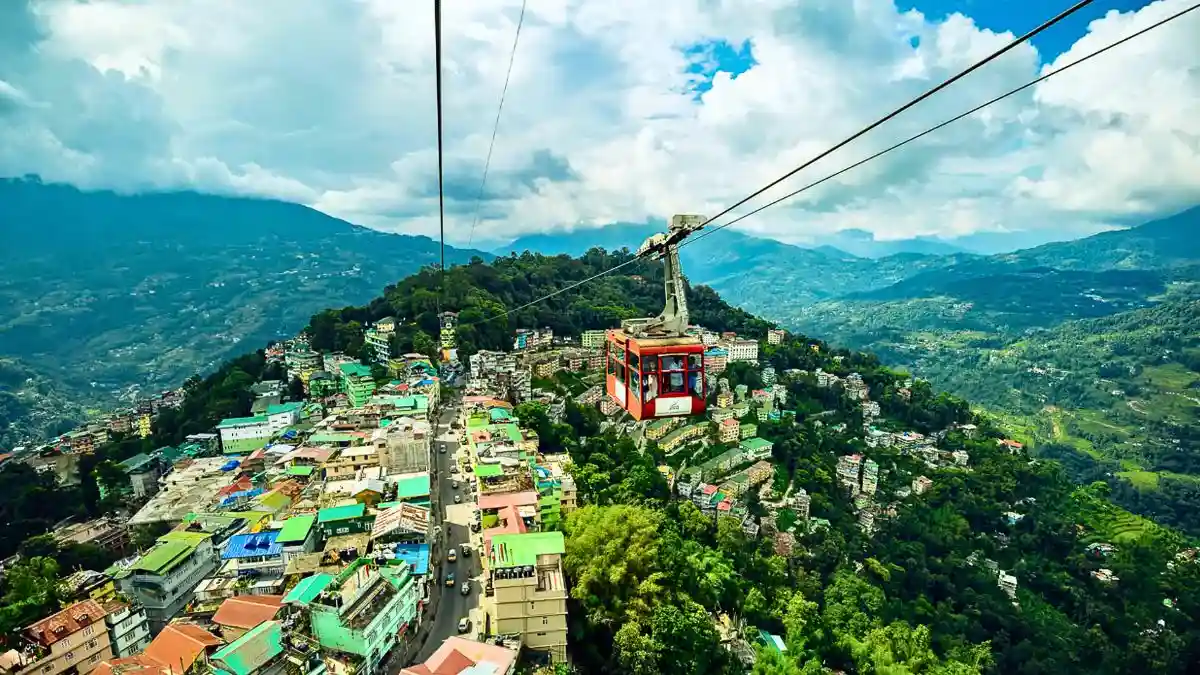
Gangtok is one of the populous states of Sikkim and offers a number of places to be visited by tourists. Gangtok is the capital of Sikkim and offers a number of attractions and a taste of culture and traditions along with vibrant markets, stunning views, and alluring places to visit. The city offers serene beauty and lush green forests that will offer you mental peace. There are several activities that you can seek in Gangtok, which include mountain biking, river rafting, cable car rides, and others. Some spots across Gangtok attract a number of tourists from different parts of India.
Gangtok Travel Tips
The best time to visit Gangtok is between March and April and between October and November. It is also advisable to avoid planning a trip to Gangtok during the rainy season, as you may face roadblocks, landslides, and restrictions to different points. The most crowded place in Gangtok is MG Marg Road, which has a number of hotels and shops.
Gangtok Facts
Gangtok does not have any direct railway station or airport thus the nearest railway station is New Jalpaiguri Railway Station (NJP) and the nearest airport is Bagdogra Airport (IXB). Bagdogra Airport is located at a distance of 123 km and may take around 4 hours and 30 minutes and from NJP it will take around 4 hours and 10 minutes to cover a distance of 118 km. Moreover, MG Marg Road in Gangtok is the first litter and spit-free town in India.
There are also a number of festivals and events that occur in Gangtok across the year such as the Sikkim Red Panda Winter Festival, Gangtok Food and Culture Festival, Daga Dawa, Guru Rimpoche’s Thunkar Tshechu, and others.
Main Highlights
- Gangtok highlights the Buddhist culture and serenity.
- Gangtok offers a peaceful ambiance and panoramic views.
| Place Name | Type | Distance from Gangtok (in km) |
| Ban Jhakri Falls Park | Nature Park | 7.5 |
| Gangtok Ropeway | Point of Interest | 1.9 |
| M G Marg | Point of Interest / Marketplace | 0.8 |
| Lingdum Monastery | Religious SIte | 15.4 |
| Hanuman Tok | Point of Interest | 7.9 |
| Black Cat Museum | Museum | 3.5 |
| Ganesh Tok Viewpoint | Point of Interest | 5.1 |
| Nathula Pass Viewpoint | Point of Interest | 52.2 |
| Enchey Monastery | Religious SIte | 3 |
| Tashi Viewpoint | Point of Interest | 7.3 |
| Menmecho Lake | Lake | 58.4 |
| Shri Shiv Temple | Religious SIte | 5.5 |
| Deorali Orchid Sanctuary | Point of Interest | 1.9 |
Yuksom
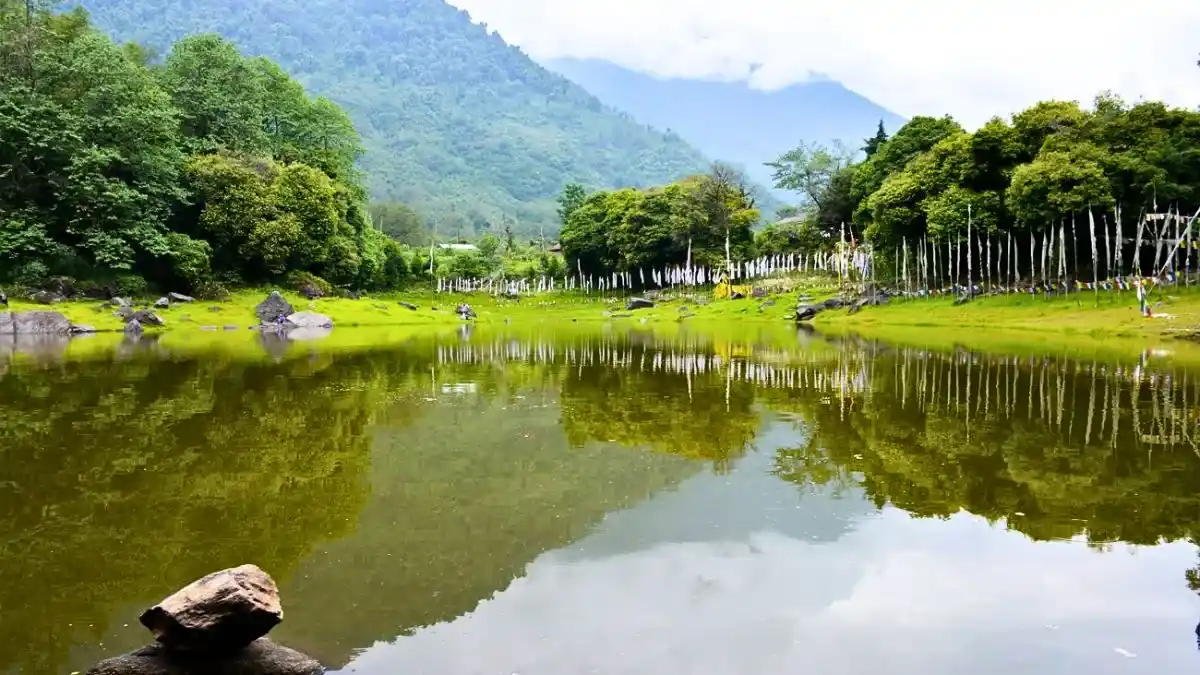
Yuksom is the ancient capital of Sikkim, which is located amidst the snow-capped mountains and alluring landscape. The town holds religious importance to religious places and monasteries associated with Buddhism. Yuksom refers to the meeting point of three Lamas, who met there to crown the first King of Sikkim.
Yuksom Travel Tips
The best time to visit is between March to June and September to October as it will be the ideal time for sightseeing. You must ensure attaining the Inner Line Permits before visiting Yuksom and make the necessary arrangements for your stay beforehand.
Yuksom Facts
The nearest railway station to Yuksom is the New Jalpaiguri Railway Station (NJP), which is situated at a distance of 150 km and may require a travel time of 5 hours and 27 minutes (approx.). In the case of flights, the nearest airport to Yuksom is Bagdogra Airport (IXB), which is situated at a distance of 152 km and may take around 5 hours and 40 minutes to reach. The communication is mainly based on Hindi, Nepali and English.
Main Highlights
- Yuksom is the gateway to Mt. Kachengunza
- It is considered as the model for the eco-travel industry
| Place Name | Type | Distance from Yuksom (in km) |
| Tashi Tenka Monastery | Religious SIte | 52.3 |
| Dubdi Monastery | Religious SIte | 2.5 |
| Tashiding Monastery | Religious SIte | 23.8 |
| Kartok Lake | Lake | .35 |
| Coronation Throne of Norbugang | Point of Interest | .4 |
Explore other places to visit in Sikkim
| Places to Visit in Pelling | Places to Visit in Namchi |
| Places to Visit in Ravangla | Places to Visit in Lachung |
| Places to Visit in Yuksom | Places to Visit in Gangtok |
| Places to Visit in Lachen |
Tsomgo Lake
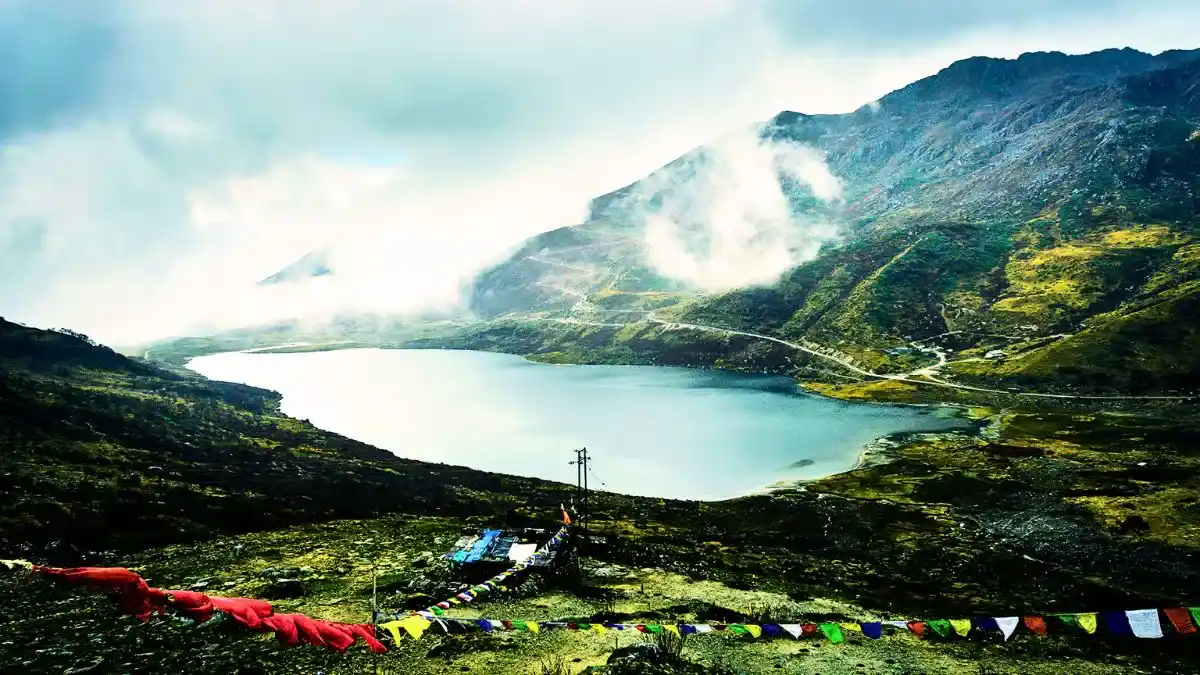
Tsomgo Lake, also known as Changgu Lake is one of the few high-altitude lakes in India. This lake can be spotted on the way to Nathula Pass and appears majestic with the reflection of the surrounding mountains. The lake is open to visitors throughout the year and offers breathtaking scenarios with the change of seasons around the year. During the winter season, the temperature may also drop below zero degrees Celsius.
Tsomgo Lake Travel Tips
If you are planning to travel to Tsomgo Lake, you must take the necessary precautions. If you have altitude sickness, hen ypu must make the necessary arrangements for oxygen as well as carry the prescribed medicines. You must contact the travel agency to schedule your journey to Tsmgo Lake along with nearby panoramic locations.
Tsomgo Lake Facts
You can reach Tsogmo Lake by road transport, which will be arranged as per your Sikkim tour package. It is also considered a sacred place by the Sikimese people. During winter, the lake is covered by snow and the are surrounded by snow capped mountains. The best time to visit Tsogmo Lake is during the autumn season, which starts in October and ends in December, as then there will be moderate temperatures and clear sky.
Main Highlights
- The lake is situated at a height of 12,313 feet above sea level.
- The lake remains frozen during the winter season.
- The lake hosts a number of migratory birds, especially the Brahminy ducks.
| Place Name | Type | Distance from Tsomgo Lake (in km) |
| Nahula Pass | Point of Interest | 16.7 |
| Baba Harbhajan Singh Temple | Religious Place | 16.5 |
| Kyongnosla Alpine Sanctuary | Point of Interest | 6.2 |
| Kyongnosla Waterfall | Waterfalls | 7.6 |
Nathula Pass
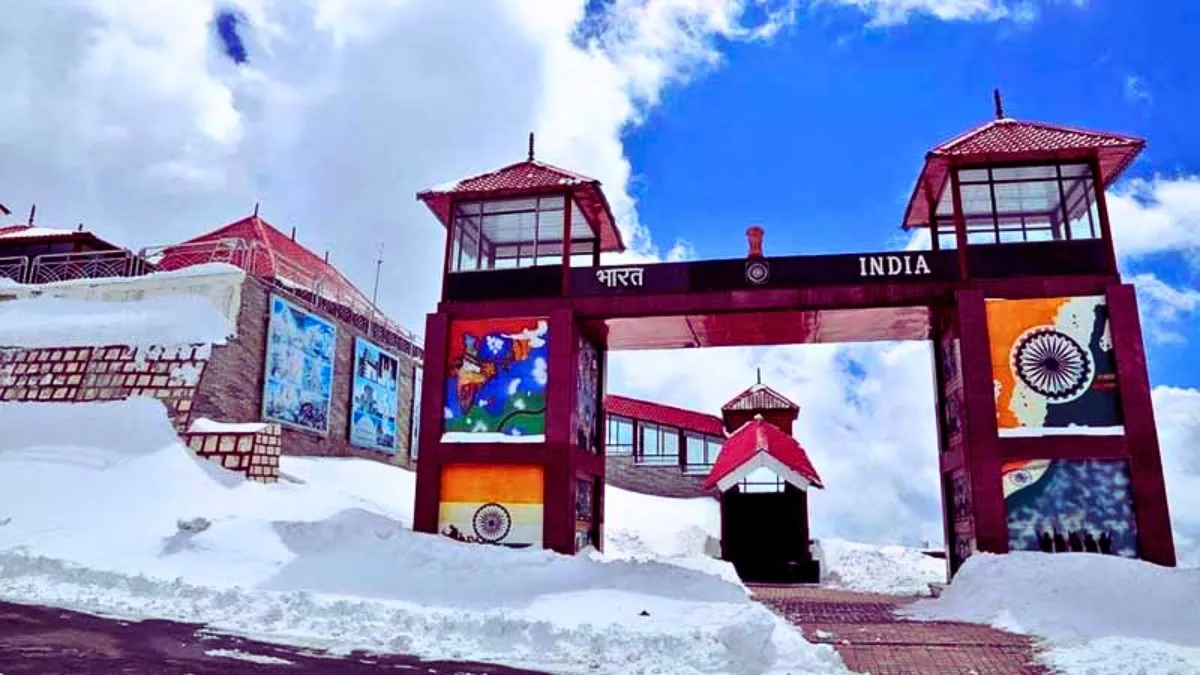
Nathula Pass is a mountain pass located in the Dongkya range of the Himalayas in the East Sikkim district and is a route that connects China’s Yadong County in Tibet and India. The past experienced heavy snowfall during winter and at times closed to tourists. Nathula Pass offers a scenic route to the border of China and stands as a witness to the resilience of the human spirit. The vibrant flags fluttering in the wind and the scenic beauty help uplift the spirit of tourism.
Nathula Pass Travel Tips
While traveling to Nathula pass, you must ensure attaining Inner Line Permits (ILP) that can be acquired either online or offline and can also be collected by your travel guide (if you have one). You must also try the local cuisines such as tingmo, thukpa, and momos.
Nathula Pass Facts
Nathula Pass can be reached using road transport. The nearest railway station to reach Nathula Pass is New Jalpaiguri Railway Station, situated at a distance of 171 km which requires a travel time of 5 hours and 42 minutes. The nearest airport is Bagdogra Airport (IXB), which is at a distance of 176 km and a travel time of 5 hours and 45 minutes.
Main Highlights
- In June, the Nathula festival occurs that highlights Sino-Indian friendship.
- The height of Nathula Pass is 14140 feet above sea level.
- The level of oxygen is comparatively lower in Nathula Pass.
| Place Name | Type | Distance from Nathula Pass (in km) |
| Baba Harbhajan Singh Temple | Religious Place | 8.4 |
| Tsomgo Lake | Lake | 16.7 |
| Pangolakha Wildlife Sanctuary | Point of Interest | 13.2 |
| Thambi Viewpoint | Point of Interest | 29.6 |
| Tulka Valley | Point of Interest | 16 |
Pelling
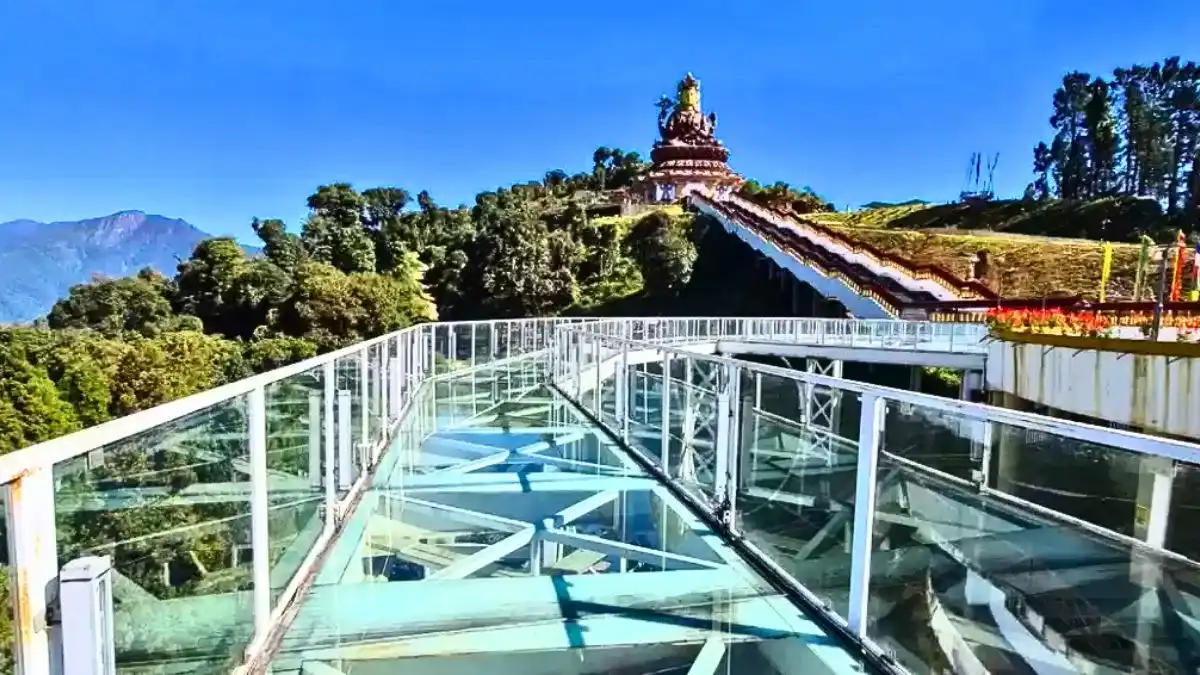
Pelling is a beautiful hill station situated in the Gyalshing district of Sikkim. The panoramic scenery and serenity attract travelers to visit this destination from different parts of India. There are a number of activities that can be participated by the tourists such as tours, rock climbing, and mountain biking.
Pelling Travel Tips
The best time to visit Pelling is in the winter season, which is between October to February. A moderate climate prevails over Pelling throughout the year and this destination also serves as a route to different treks.
Pelling Facts
The nearest railway to Pelling is New Jalpaiguri Railway Station (NJP), which is located at a distance of 132 km. The nearest airport to Pelling is Bagdogra Airport (IXB), situated at a distance of 137km.
Main Highlights
- Pelling is located at a height of around 7200 feet.
- It is home to some of the oldest monasteries of Sikkim.
- A number of trekking trails start from Pelling.
| Place Name | Type | Distance from Pelling (in km) |
| Pemayangste Monastery | Religious Place | 8.9 |
| Rabdentse Ruins | Point of Interest | 9.2 |
| Khencheopalri Lake | Lake | 32.3 |
| Chenrezig Statue | Point of Interest | 9.3 |
| Singshore Bridge | Point of Interest | 27.8 |
| Kanchenjunga Falls | Waterfalls | 30.4 |
| Sky Walk Pelling | Point of Interest | 9.2 |
| Sangay Falls | Waterfalls | 30.4 |
| Sanghak Choeling Monastery | Religious Place | 8.9 |
| Rimbi Waterfalls | Waterfalls | 18.2 |
Lachen
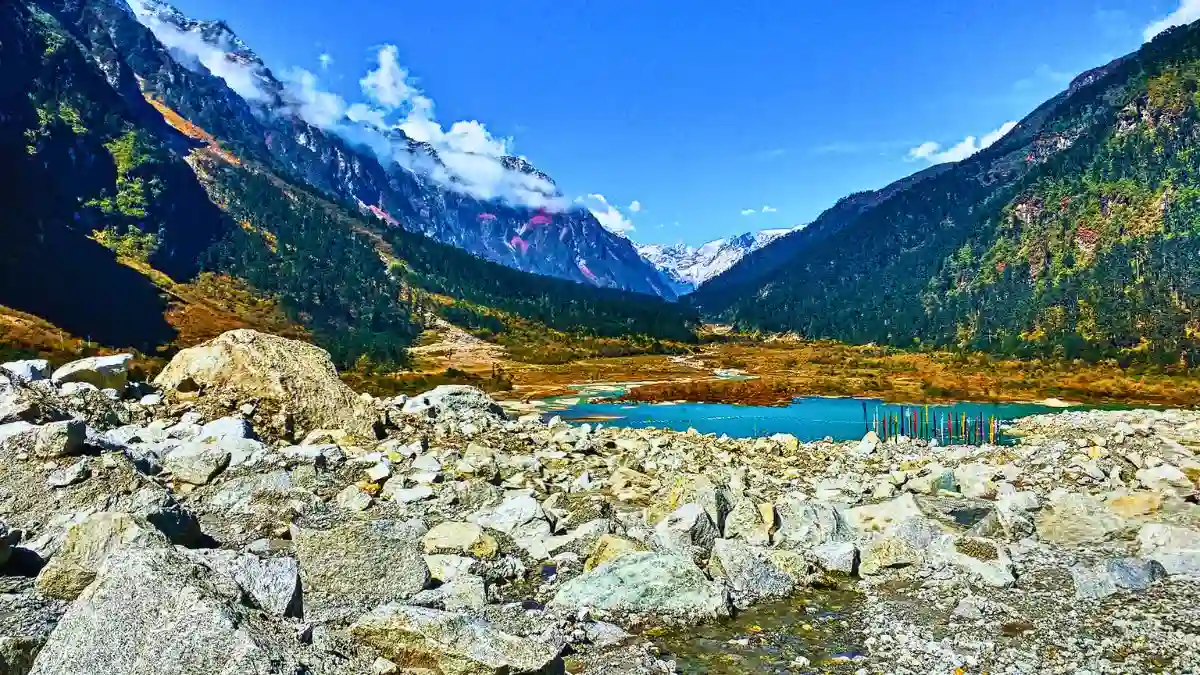
Lachen is a scenic town located in the Mangan district of North Sikkim that offers serene tranquility, rich cultural heritage, and breathtaking scenery. Lachen also serves as a base for Chopta Valley and Gurudongmar Lake. Lachen offers a serene escape to travelers from the hustle of city life. There are a number of tourist spots around Lachen that offer panoramic views to the tourists and help them enjoy the solitude.
Lachen Travel Tips
At the time of traveling to Lachen, you must ensure booking for your rooms and transport arrangements, especially during peak season. You must also ensure attaining the Inner Line Permits.
Lachen Facts
You need to visit Lachen by road transport as the nearest airport to Lachen is Bagdogra Airport (IXB), which is located at a distance of 204 km and the nearest railway station is New Jalpaiguri Railway Station (NJP), situated at a distance of 197 km. During summer, Thangu, an annual yak race is also held in this town. You can also opt for yak rides on the way to Chopta Valley.
Main Highlights
- Lachen is situated at 8838 feet (approx.) above sea level.
- A base for travelers visiting Gurudongmar Lake and Chopta Valley
| Place Name | Type | Distance from Lachen (in km) |
| Chopta Valley | Point of Interest | 16.2 |
| Gurudongmar Lake | Lake | 64.3 |
| Lachen Monastery | Religious Place | 3.4 |
| Shingba Rhododendron Sanctuary | Point of Interest | 59.3 |
| Thangu Valley | Point of Interest | 32 |
| Lhonak Valley | Point of Interest | 55.1 |
Lachung

Lachung is a serene town at a high altitude, surrounded by mountains, and is loathed in the Northeast Sikkim. The surreal and untouched beauty attracts a large number of tourists across different parts of India to visit this place. There are a number of places around Lachung that offer visitors scenic views and unforgettable experiences which makes it one of the best places to visit in Sikkim.
Lachung Travel Tips
During the monsoon season, Lachung is inaccessible due to heavy rainfall and during winter there are chances of heavy snowfall, which affects the routes and leads to the closure of different places, roads, and treks. The trip to Lachung must have sufficient time, as the roads at times may not be in good condition, which may delay the travel time. The best time to visit Lachung is between March and May when the snow starts to melt and the visibility of the surrounding nature is enhanced.
Lachung Facts
Joseph Dalton Hooker, who is a British botanist, in his book “The Himalayan Journal” has labeled Lachung as the most picturesque village of Sikkim. Lachung is surrounded by a number of fruit orchards and glacial rivers that add to its charm. The nearest airport to Lachung is Bagdogra Airport (IXB) which is at a distance of 196 km and the nearest railway station is New Jalpaiguri Railway Station (NJP), located at a distance of 191 km.
Main Highlights
- Lachung is situated at an altitude of 9600 feet above sea level.
- Lachung is renowned for its surrounding mountains and lakes.
| Place Name | Type | Distance from Lachung (in km) |
| Zero Point | Point of Interest | 51.1 |
| Yumthang Valley | Point of Interest | 25.8 |
| Lachung Monastery | Religious Place | 0.9 |
| Naga Falls | Waterfall | 34.1 |
| Bhewma Falls | Waterfall | 0.55 |
| Lachung river | River | 21.7 |
Ravangla

Ravangla is situated amidst the Tendong and Maenam hills of South Sikkim and offers a mesmerizing blend of rich culture, vibrant landscape, and peaceful tranquility. This hill station also hosts some of the popular treks in Sikkim, which attracts adventure enthusiasts from different parts of the country.
Ravangla Travel Tips
The weather in Ravangla is unpredictable, which needs to ensure taking precautions of facing uncertain rainfall. The best time to visit Ravangla is Spring (March-May) and Autumn (September-November).
Ravangla Facts
Ravangla is a popular bird lover paradise as it is home to some of the endangered species of birds as well as migratory birds such as white-browned fantails, verditer flycatchers, gray bush chat, blue-fronted restarts, and others. During the period of April and May, a variety of flowers are seen to bloom in Ravangla offering a picturesque scenario to the visitors.
The nearest airport to Ravangla is Bagdogra Airport, which is at a distance of 127 km and the nearest railway station is New Jalpaiguri Railway Station (NJP), situated at a distance of 122 km.
Main Highlights
- The peaks of Mt. Sinialchu, Mt. Pandim, and Mt. Kanchenjunga can be seen clearly.
- A number of migratory birds can be seen by tourists.
- The exotic flora and fauna help in enhancing the scenic beauty of Ravangla.
| Place Name | Type | Distance from Ravangla (in km) |
| Buddha Park | Park | 1.1 |
| Samdruptse Hill | Point of Interest | 22.2 |
| Talong Monastery | Religious Place | 5.2 |
| Maenam Wildlife Sanctuary | Point of Interest | 3.5 |
| Doling Gompa | Religious Place | 4.3 |
| Ralong Hot Springs | Point of Interest | 43.3 |
| Rayong Sunrise Viewpoint | Point of Interest | 8.7 |
Rumtek Monastery
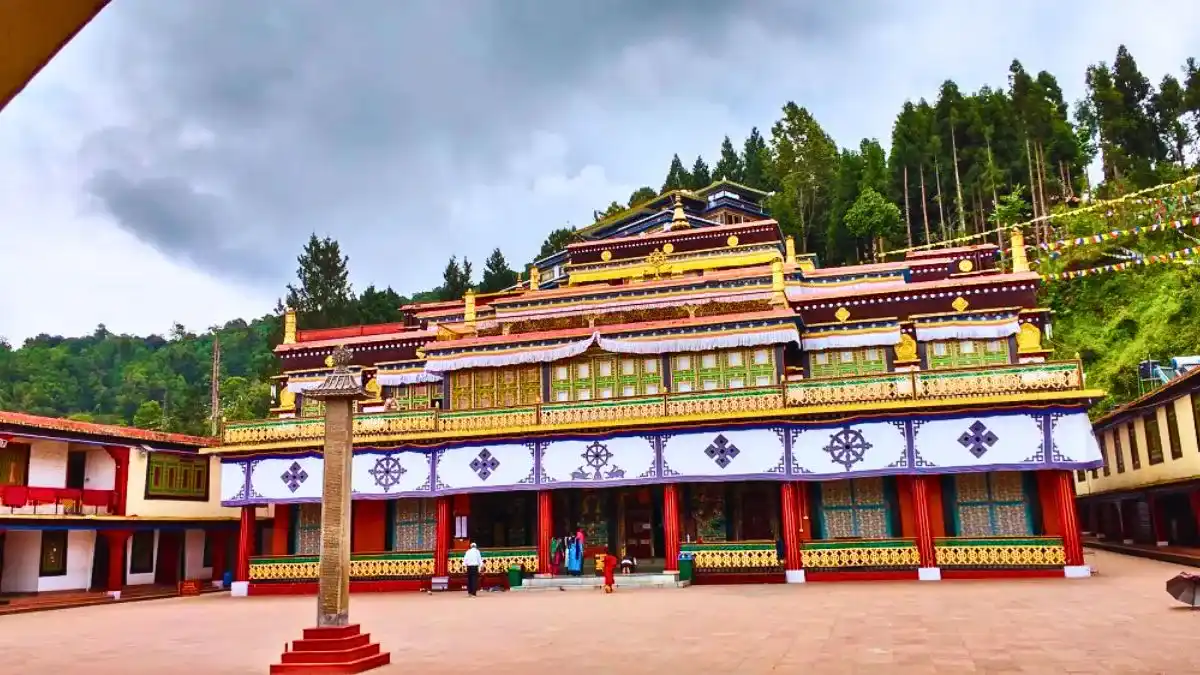
Rumtek Monastery is one of the largest monasteries in Sikkim, as well as one of the oldest monasteries. This monastery is also known as the Dharma Chakra Centre and stands as a testimony of the rich traditions and culture of Buddhism. It is located near Gangtok at a distance of 21.7 km.
Rumtek Monastery Travel Tips
The monastery remains open from 6 am to 6 pm and the entry fee of Rs 10 per person is being charged. Photography is not allowed inside the monastery but outside the building. The dress to be worn by the tourists needs to be below the knees, as anything above the knees is considered disrespectful. Moreover, smoking is restricted within the monastery and women must avoid causing any physical contact with the monks residing in the monastery.
Rumtek Monastery Facts
It is believed that the Rumtek monastery is a replica of the original monastery in Tsurpu in Tibet. The monastery is also renowned for offering Kagyu teachings. The monastery is also considered to have the rarest religious artwork of Buddhists in the form of 1001 miniature golden models of Buddha that were brought in the year 1963 by Rangjung Rigpe Dorje.
Main Highlights
- Golden Stupa is present at the monastery which is 13 feet high.
- The monastery depicts the best of Tibetan architecture.
- One of the renowned centers for Kagyu teachings.
| Place Name | Type | Distance from Rumtek Monastery (in km) |
| Shanti Viewpoint | Point of Interest | 3.9 |
| Saramsa Garden | Point of Interest | 16.4 |
| Black Cat Museum | Museum | 18.2 |
| M G Marg | Point of Interest | 21.3 |
| Hanuman Tok | Religious Place | 29.6 |
| Banjhakri Waterfalls | Waterfall | 16.3 |
| Jawaharlal Nehru Botanical Garden | Nature Park | 0.6 |
Hanuman Tok
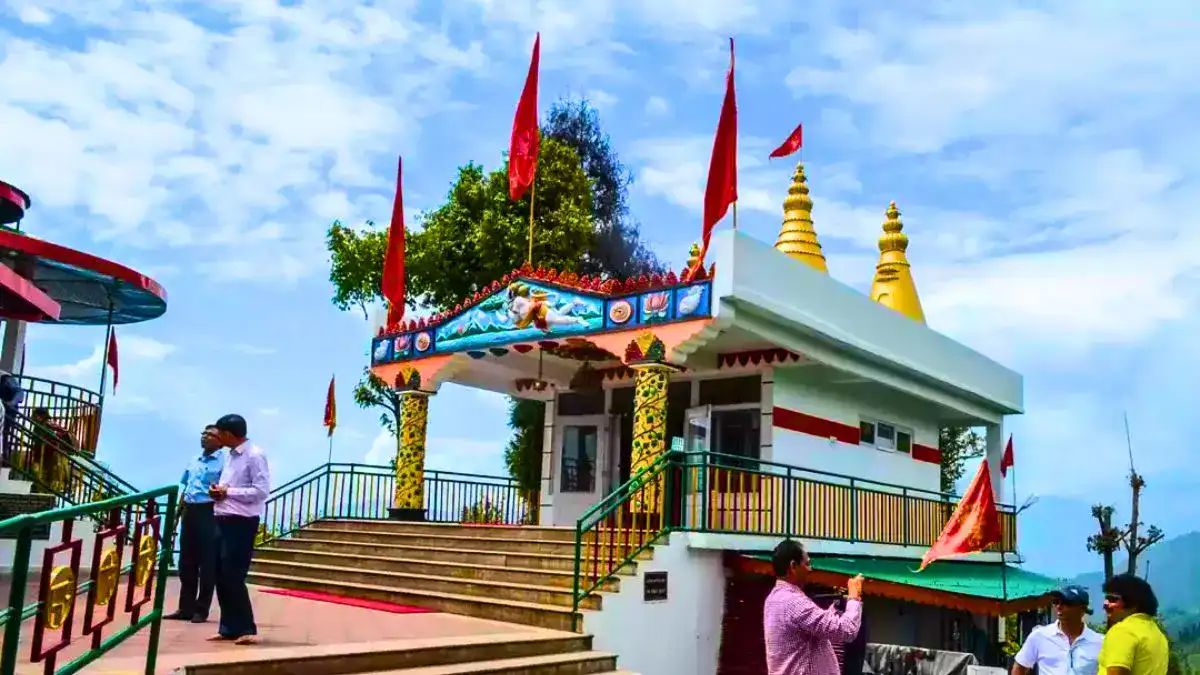
Hanuman Tok is located in Gangtok and is situated on a hilltop and is more than a Hindu temple, which is devoted to Lord Hanuman. The serene ambiance, breathtaking panorama, and spiritual significance help in attracting both travelers and pilgrims to visit this place.
Hanuman Tok Travel Tips
Hanuman Tok is situated at a distance of 7.9 km from Gangtok which requires a travel time of around 20 minutes. You must book a taxi to travel to Hanuman Tok from your hotel. Taking pictures of the deity is not allowed, but you can take pictures outside the temple. While traveling from Gangtok, you may reserve a private taxi or opt for a shareable taxi to reach Hanuman Tok.
Hanuman Tok Facts
As per local legend, it is said that Lord Hanuman rested in this place while carrying back the Sajeevani herb to revive Lakshmana who had been injured in Ramayana. The Indian army maintains the temple complex helps maintain a serene atmosphere. The vibrant prayer flags and greenery help in enhancing the spiritual ambiance.
Main Highlights
- You are not allowed to take pictures of the deity.
- The temple is being maintained by the Indian army as the entire area was handed to them back in the year 1968.
- The temple is renowned for wish fulfillment.
| Place Name | Type | Distance from Hanuman Tok (in km) |
| Enchey Monastery | Religious Place | 4.7 |
| Ganesh Tok | Religious Place | 3.7 |
| Tashi Viewpoint | Point of Interest | 8.4 |
| Ban Jhakri Falls | Waterfall | 15.4 |
| Bakthang Waterfall | Waterfall | 11.4 |
| Do Drul Chorten Monastery | Religious Place | 10.4 |
Buddha Park
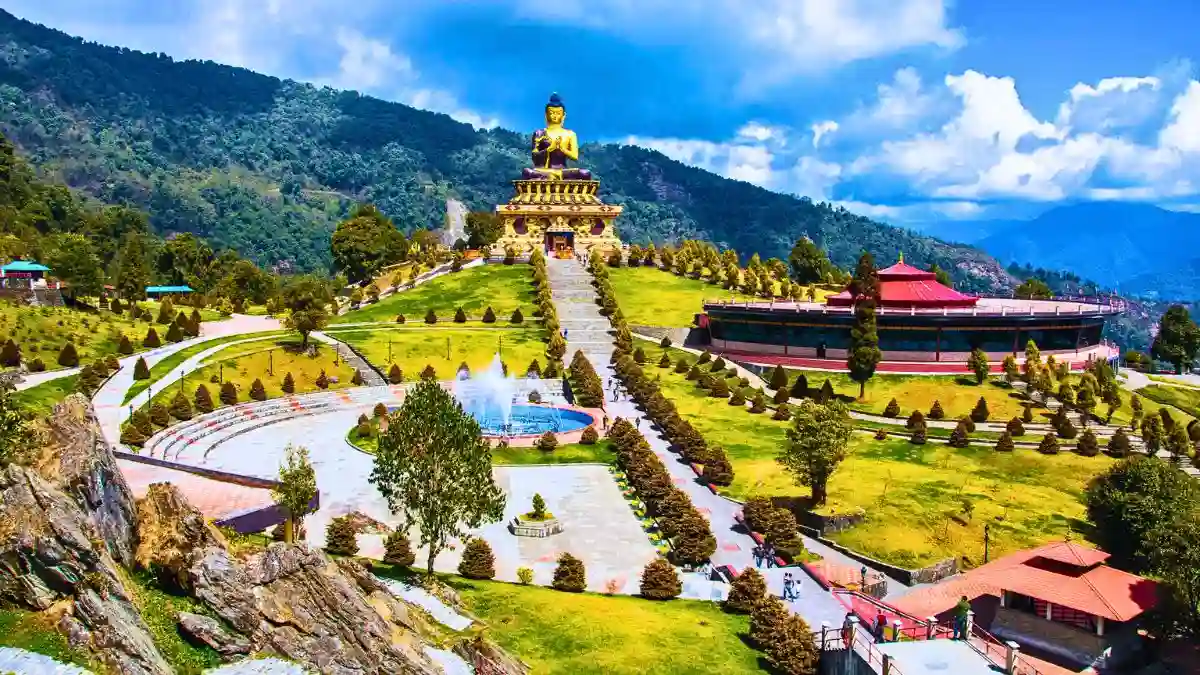
Buddha Park is located in Ravangla, South Sikkim, and is also known as Tathagata Tsal. This Buddha park features a 130-foot tall statue of Gautam Buddha, which is considered the centerpiece of the park. This park was inaugurated by the 13th Dalai Lama back in the year 2013. The park is located at a distance of 1.1 km from Ravangla and will take around 5 minutes to reach there by car.
Buddha Park Travel Tips
At the time of visiting Buddha Park, you must take into account that the park is open from 9 am to 5 pm and requires an entry fee of Rs 50 for adults and Rs 25 for children. It has also been observed that the park gets crowded on the weekends. If you are planning to visit Buddha Park, you need to book your accommodation in advance, especially in peak season. The best time to visit Buddha Park is between April and June, however, for snow lovers, you can visit the park between September to November.
Buddha Park Facts
Buddha Park was built to celebrate the 2550th birthday of Lord Buddha in 2006 and it can be reached using only road transport. The Buddha park is surrounded by mountains and offers scenic views to some of the renowned mountain ranges such as Mt. Kabru, Mt. Siniolch, Mt Pandim, and Mt Kanchenjunga.
Main Highlights
- The Cho Djo Lake is located within the complex of Budha Park.
- The park was built between 2006 and 2013 and features a 40-meter-tall statue of Lord Buddha as its centerpiece.
- The Buddha Park stands as a testament to the Buddhist community.
| Place Name | Type | Distance from Buddha Park (in km) |
| Maenam Wildlife Sanctuary | Point of Interest | 2.4 |
| Pemayangtse Monastery | Religious Place | 43.3 |
| Rabdentse Ruins | Point of Interest | 42.4 |
| Ralang New Monastery | Religious Place | 9.1 |
| Tashiding Monastery | Religious Place | 36.4 |
Mahatma Gandhi Marg
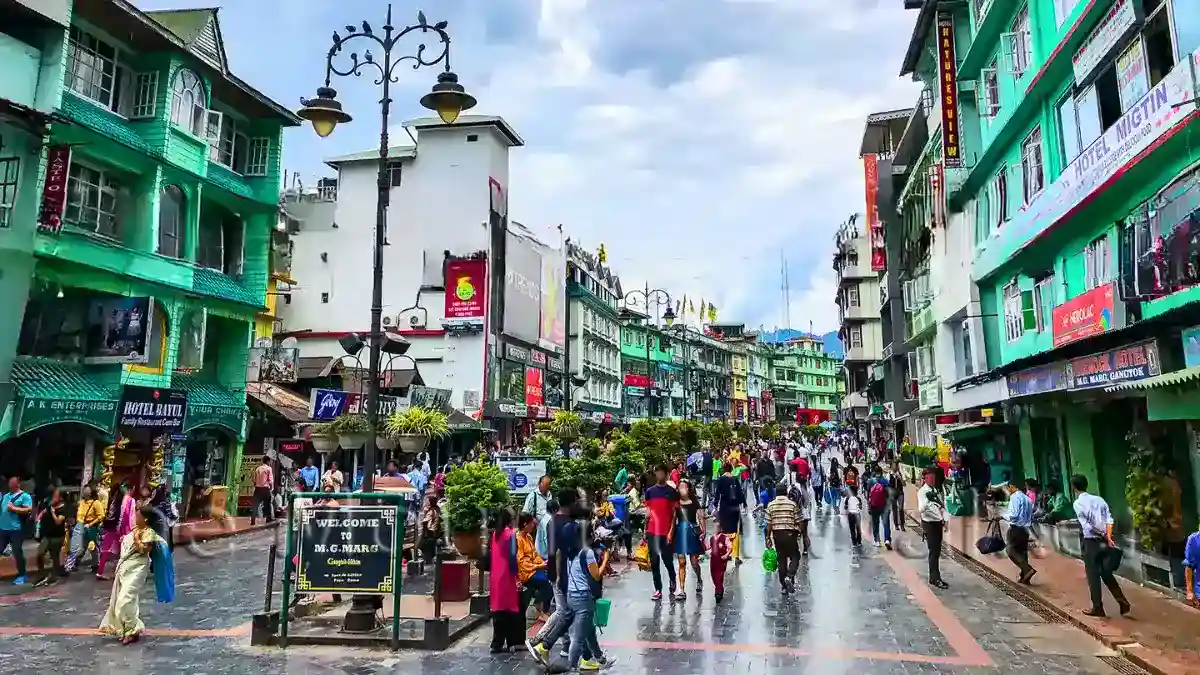
Mahatma Gandhi Marg or MG Marg is a renowned road in Gangtok. The road has a statue of Mahatma Gandhi, for which the name of the road is Mahatma Gandhi Marg. It is also a popular tourist attraction due to a variety of shops, restaurants, hotels, and cafes. This location also allows tourists to people watch and witness music shows and traditional dance performances. It is also considered a shopper’s delight as tourists may find a wide array of products that may match their needs and preferences.
Mahatma Gandhi Marg Travel Tips
MG Marg offers tourists a number of options from shopping to dining and accommodation. The Sikimmese are welcoming so be sure to respect their traditions and culture.
Mahatma Gandhi Marg Facts
Mahatma Gandhi Marg is located in the center of Gangtok and attracts people of different age groups. Less than a kilometer, this stretch is filled with shops, cafes, restaurants, hotels and pubs. The entire area is maintained strictly under the government rules to promote green initiatives making the zone free of vehicular traffic, litter, and smoke.
Main Highlights
- MG Marg is also called “London Street” due to the ambiance developed by bakery shops, paved pathways, and Victorian-style street lights.
- MG Marg depicts the union between India and Sikkim back in 1975.
- The majority of the shops and hotels have sloping roofs to reduce the gathering of snow or rainwater.
| Place Name | Type | Distance from Mahatma Gandhi Marg (in km) |
| Gangtok Ropeway | Point of Interest | 2.4 |
| Hanuman Tok | Religious Place | 7.5 |
| Ban Jhakri Falls | Waterfall | 8.3 |
| Ganesh Tok | Religious Place | 5.3 |
| Enchey Monastery | Religious Place | 3.2 |
| Do Drul Chorten | Religious Place | 3 |
| Bakthang Waterfall | Waterfall | 5 |
Namchi
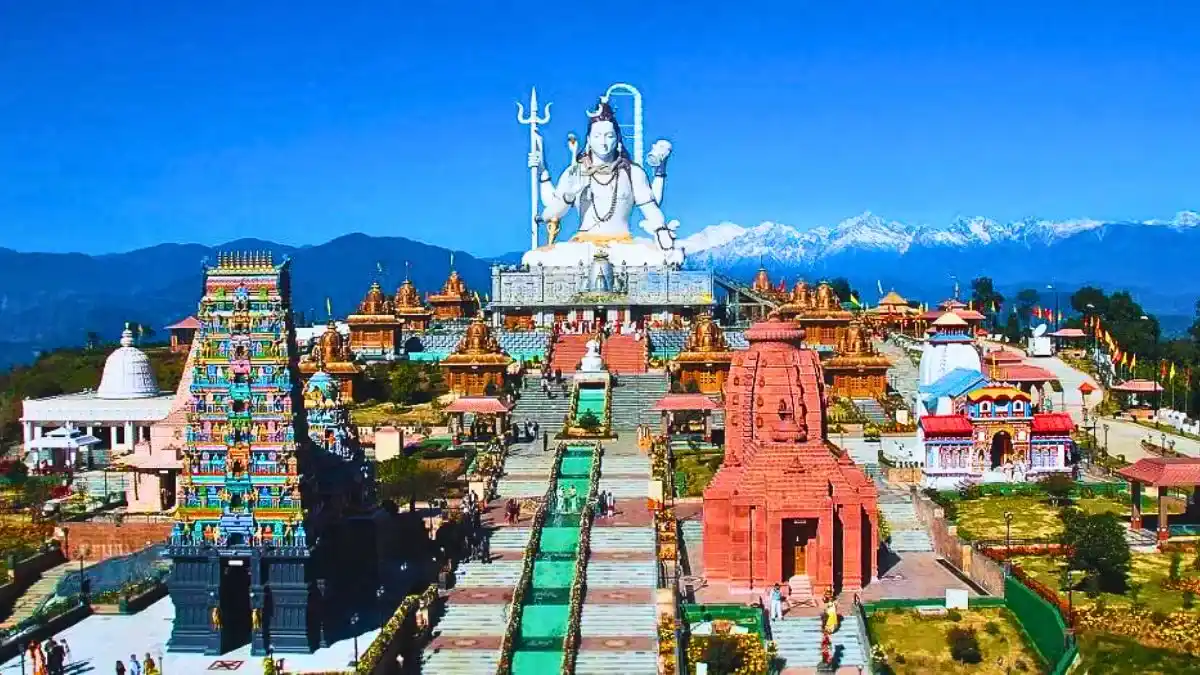
Namchi is a Tibetan word meaning “Top of the sky, as it is situated at a height of 5500 feet. Namchi is situated at a distance of 92km from Gangtok and offers a scenic viewpoint. Namchi also holds some of the scenic and heritage sites of Sikkim that attract tourists from different parts of India. Namchi is located in South Sikkim and offers serene monasteries, breathtaking panoramas, and offers cultural immersion to travelers. It also offers trekking options for travelers seeking adventure.
Namchi Travel Tips
The best time to visit Namchi is between March and May, as the temperature during these months remains moderate. One must avoid visiting Namchi during monsoon, as there are chances of facing roadblocks, and landslides, and trekking is halted for a temporary period.
Namchi Facts
Namchi offers tourists a number of attractions that consist of cultural sites, breathtaking vistas, and serene monasteries. Namchi also offers the world’s largest statue of Buddhist Padmasambhava, also known as Guru Rinpoche. This statue is 118 feet tall and attracts a number of tourists and devotees to visit the Samdeuptse hill. The hill is situated at a distance of 5.7 km, which may take up to 15 minutes of traveling time by car.
Main Highlights
- During October, Namchi Mahotsav is held every year, which is celebrated as a festival.
- The annual flower show is held in February, which displays exotic flowers.
- Local markets offer traditionally handcrafted items and local spices.
| Place Name | Type | Distance from Namchi (in km) |
| Char Dham | Religious Place | 5.3 |
| Siddheswar Dham | Religious Place | 4.9 |
| Tendong Hill | Point of Interest | 10.3 |
| Tarey Bhir | Point of Interest | 29.0 |
| Sai Mandir | Religious Place | 4.8 |
| Ngadak Monastery | Religious Place | 4.0 |
| Namchi Ropeway | Point of Interest | 5.1 |
Do-Drul Chorten
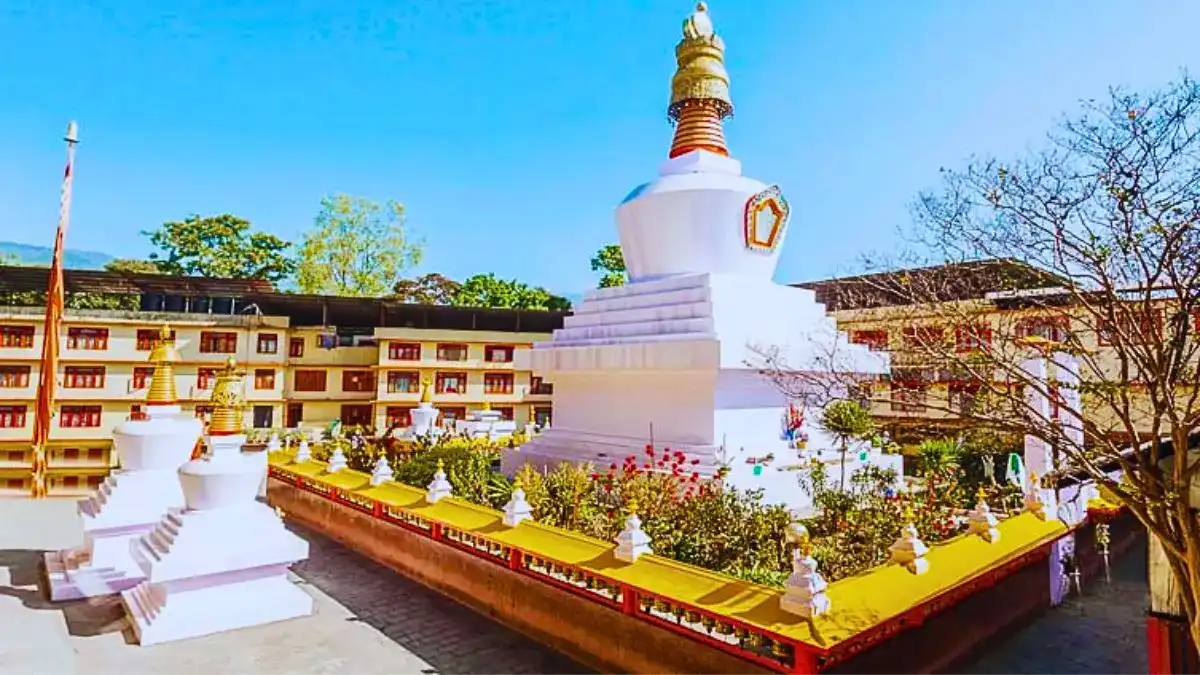
Do-Drul Chorten is also called Do-Drul Stupa, which is a popular tourist attraction in Gangtok and depicts the bond between spirituality and history. The historical significance, peaceful ambiance, and cultural immersion help in attracting tourists and spiritual enthusiasts to visit this place. Do-Drul Chorten was built by Trulshik Rinpoche back in the year 1945 to cast away the evil spirits that are believed to reside in the area. This place also has a complete set of Dorjee Purba kangyur and other religious objects.
Do-Drul Chorten Travel Tips
Do-Drul Chorten is situated at a distance of 2.5 km from Gangtok, which requires a travel time of 15 minutes (approx.). There is no entry fee for entering into this stupa and is open to the public on all days from 8 am to 6 pm. The best time to visit this place is between October and June. Being close to the town, it can be easily accessible using a car, taxi or by walking. It is advised to maintain silence to respect the sanctity of the stupa and also ensure avoiding climbing on religious objects.
Do-Drul Chorten Facts
Do-Drul Chorten was built by Truslshi Rinpoche in 1945 when invited by the Queen of Sikkim, after World War 2. The stupa reflects the local Tibetan Buddhist practices and traditions.
Main Highlights
- It is surrounded by 108 Mani Lhakors that devotees rotate to gain spiritual merit.
- The complex offers shelters to around 700 Buddhist monks.
- Offers the opportunity to observe the pilgrims and monks engaged in prayers and other religious activities.
| Place Name | Type | Distance from Do-Drul Chorten (in km) |
| Namgyal Institute of Technology | Point of Interest | 0.55 |
| Gangtok Ropeway | Point of Interest | 0.6 |
| Enchey Monastery | Religious Place | 5.4 |
| Ban Jhakri Waterfalls | Waterfalls | 7.6 |
| Ganesh Tok | Religious Place | 6.9 |
| Hanuman Tok | Religious Place | 9.8 |
Jawaharlal Nehru Botanical Garden
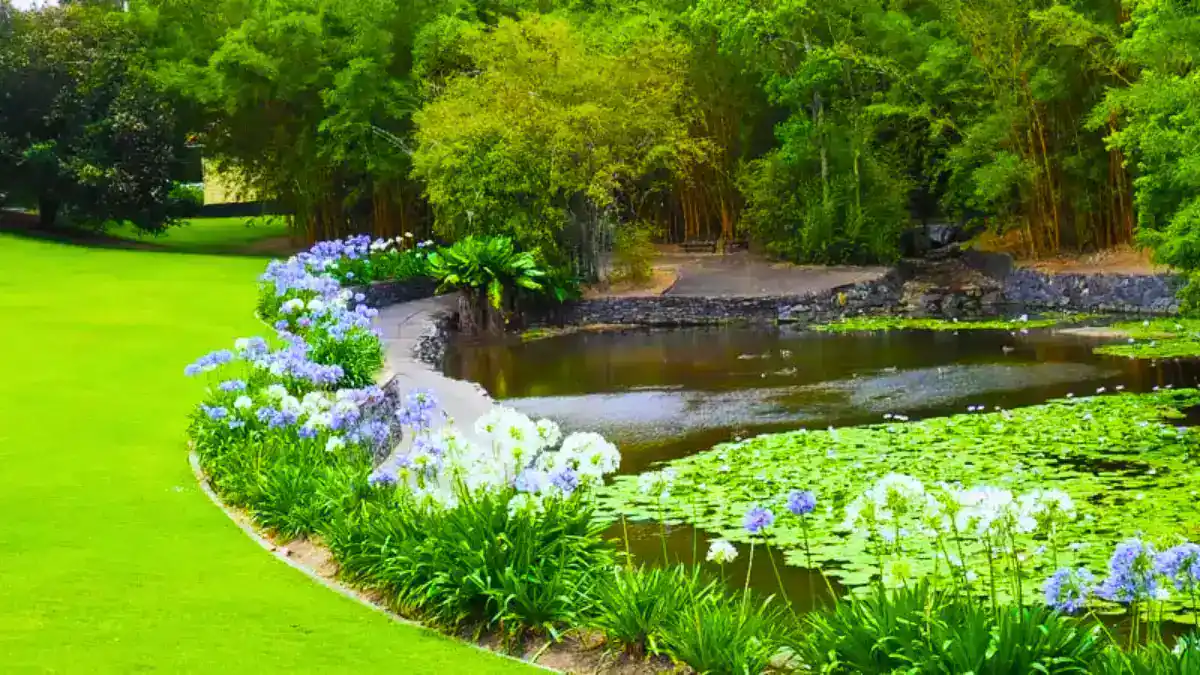
Jawaharlal Nehru Botanical Garden is located very close to Rumtek Monastery, at a distance of 600 meters. This botanical garden is home to thousands of rare and exotic species of trees and plants such as cacti, rhododendrons, orchids, and others. The botanical garden offers a lush green beauty and a walking trail to the visitors to help them enjoy and relax within the natural beauty.
Jawaharlal Nehru Botanical Garden Travel Tips
Jawaharlal Nehru Botanical Garden is open from 8 am to 6:30 pm and requires an entry fee of Rs 10 for adults and Rs 5 for children. The distance between Jawaharlal Nehru Botanical Garden and Gangtok is 21.2 km and requires a travel time of around 52 minutes to reach via car.
The best time to visit this place is between March and May, as it is the blooming season of different flowers that make picturesque scenery. Again, during the winter, between October and mid-December, the scenery is changed with the snow-capped mountains and valleys
Jawaharlal Nehru Botanical Garden Facts
Jawaharlal Nehru Botanical Garden offers a wide array of trees, plants, and flowers that attracts tourists. The botanical garden has an estimate of over 1.5 lakh plants, including a cluster of oak trees.
Main Highlights
- The botanical garden was established in the year 1987 and is maintained by the Forest Department of the Government of Sikkim.
- The orchid house reserves a collection of over 500 different orchid species.
- The cactus garden offers a collection of over 200 different species of cacti.
| Place Name | Type | Distance from Jawaharlal Nehru Botanical Garden (in km) |
| Rumtek Dharma Chakra | Religious Place | 0.55 |
| Lingdum Monastery | Religious Place | 13.6 |
| Bakthang Waterfall | Waterfall | 24.0 |
| Ban Jhakri Waterfall | Waterfall | 15.7 |
| Buddha Park | Point of Interest | 61.3 |
| Do-Drul Chorten | Religious Place | 19.9 |
Zuluk
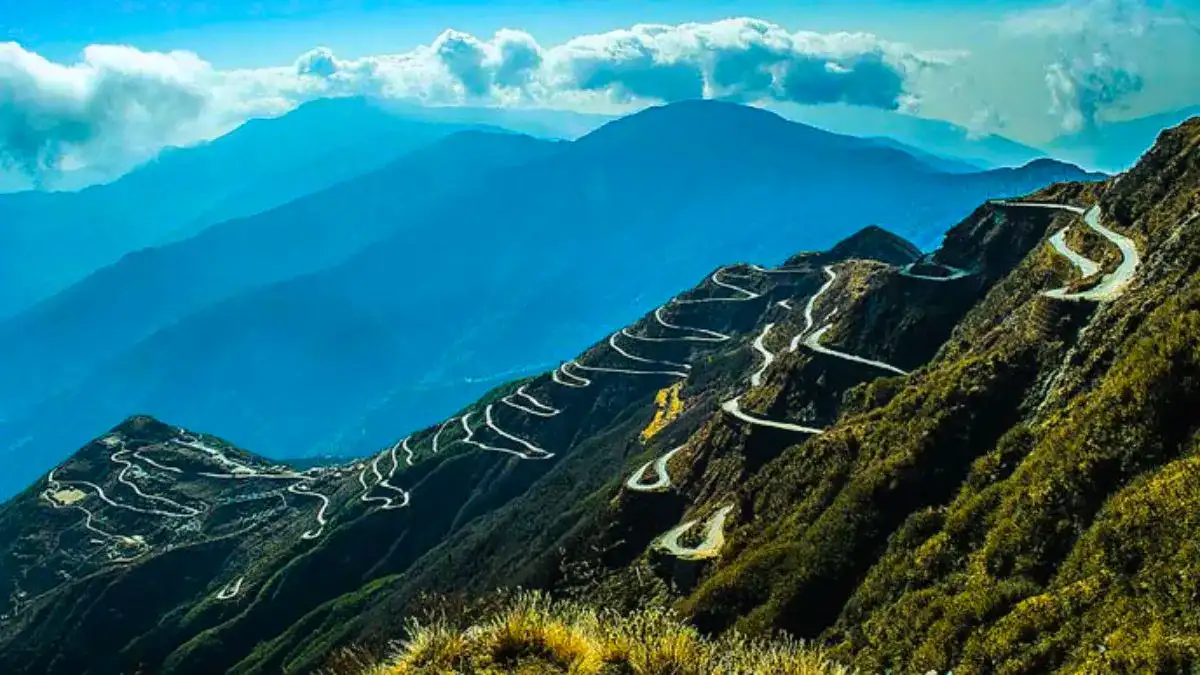
Zuluk or Dzuluk is a Himalayan hamlet that is situated in East Sikkim of the lower Himalayas at an altitude of 10,100 feet above sea level. This small village was once a transit point of the Silk Route in between Tibet and India. At present, it attracts nature lovers and adventure seekers offering them serene landscapes within the Himalayas.
Zuluk Travel Tips
If you are planning to visit Zuluk, you must acquire the Protected Area Permit (PAP) for visiting Zuluk. Moreover, the off-beat path experience offers thrill and adventure to the tourists along with breathtaking mountain views. The best time to visit Zuluk is between August and September, as it offers pleasant weather and a breathtaking landscape. Zuluk can be accessible by using road transport is situated at a distance of 87.8 km and requires a travel time of 3 hours and 3 minutes.
Zuluk Facts
Zuluke offers panoramic vistas of the Eastern Himalayas to the tourists, which helps it in emerging as a tourist destination. Zuluk helps in preserving the remnants of the silk route before the invasion of the Chinese in Tibet. At times there are sightings of Himalayan bears, wild dogs, deer, and red panda.
Main Highlights
- Zuluk accommodates a population of 700 people.
- An Indian army base is located in Zuluk that serves as a transit camp for army movement.
| Place Name | Type | Distance from Zuluk (in km) |
| Thambi Viewpoint | Point of Interest | 14.1 |
| Eco Nature Park | Nature Park | 5.0 |
| Lungthung Viewpoint | Point of Interest | 17.9 |
| Nathang Valley | Point of Interest | 23.4 |
Namgyal Institute of Tibetology
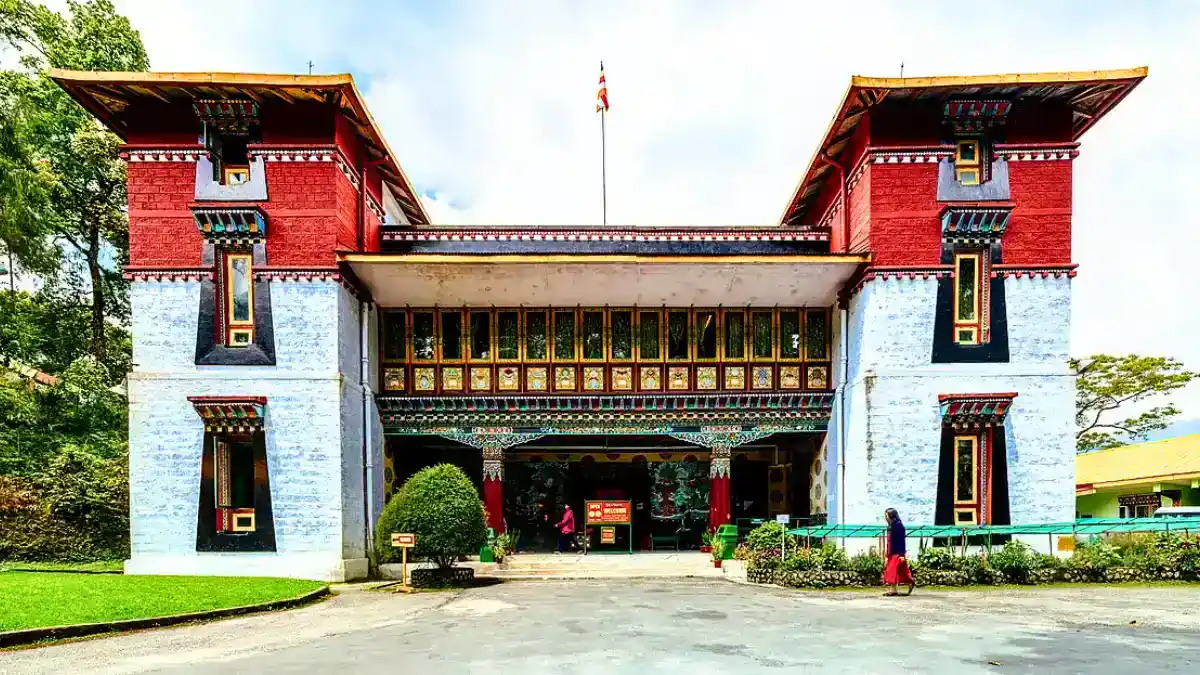
Namgyal Institute of Technology is situated only 2.2 km away from Gangtok and is a renowned institution in Sikkim. It is a premier institute that is dedicated to the
Tibetan language, history, and culture. Namgyal Institute of Technology was established in 1958 and was named after the 11th King of Sikkim, Palden Thondup Namgyal. The architectural style of the institute depicts the traditional Tibetan design as well as that of Sikimese architecture. The institute also welcomes visitors, interested in exploring Tibetan heritage, history, and culture.
Namgyal Institute of Tibetology Travel Tips
Namgyal Institute of Technology can be visited by tourists from Monday to Saturday between 10 am to 4 pm. Photography inside the museum is strictly prohibited and at the time of entering into the museum, it is mandatory to take off your shoes.
Namgyal Institute of Tibetology Facts
The foundation of Namgyal Institute of Technology was done by the first Prime Minister of India, the late Pandit Jawaharlal Nehru, on 1st October 1958, along with the 14th Dalai Lama. In 2018, the academic offering by the institute expanded, leading to the establishment of the Department for the Study of Tibetan Medicine.
Main Highlights
- Renowned for research in the areas of Tibetan culture and language.
- The museum consists of a rich collection of various things that are associated with the Himalayas and Tibet.
- You may take a guided tour to attain deep knowledge in respect for the institute and the significance of its teachings and work.
| Place Name | Type | Distance from Namgyal Insitute of Tibetology (in km) |
| Do-Drul Chorten | Religious Place | 0.55 |
| Gangtok Ropeway | Point of Interest | 0.3 |
| Enchey Monastery | Religious Place | 5.1 |
| Ganesh Tok | Religious Place | 6.7 |
| Hanuman Tok | Religious Place | 9.5 |
Yumthang Valley
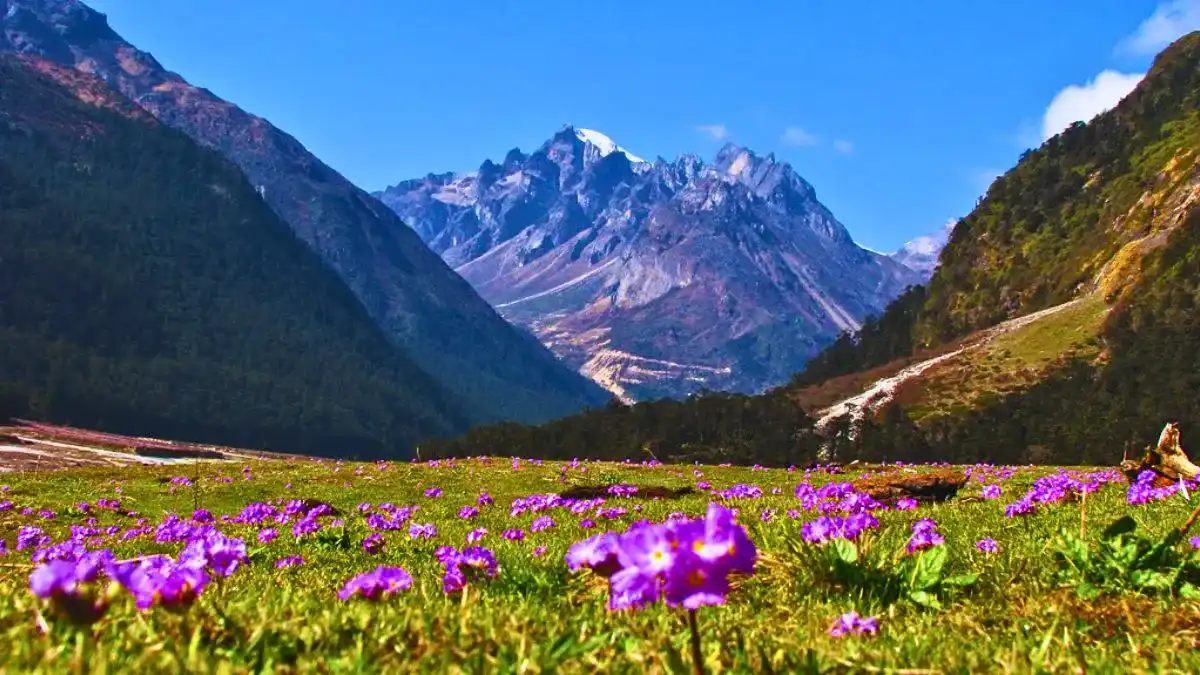
Yumthang Valley is also known as the Valley of Flowers, which is located in the northern part of Sikkim. This valley is located at a height of 3500 meters above sea level and offers breathtaking vistas and is ideal for photographers, nature lovers, and others seeking escape amidst the Himalayas from the hustle and bustle of city life.
The valley starts to transform from March to June when the colorful wildflowers across the valley bloom. Rhododendrons bloom in different shades of purple, white pink, and red across the valley offering a mesmerizing scenario.
Yumthang Valley Travel Tips
If you are planning to visit Yumhang Valley, to witness the flower blooming, you must visit from March to June. In order to witness clear skies, in the months between September to November and to witness snow-covered landscapes, one must visit between December to February. Before traveling to Yumthang Valley, you must obtain the necessary permits to visit the place.
Yumthang Valley Facts
Joseph Dalton Hooker, a British botanist, in The Himalayan Journal, has compared Yumthang valley with the valleys of Switzerland. There are different types of flowers that bloom in the Yumthang Valley, namely, irises, louseworts, cobra lilies, primulas, poppies, and rhododendrons.
Main Highlights
- There is an extensive collection of 24 different species of rhododendrons.
- Yumthang Valley is a natural sanctuary that helps in preserving the flora and fauna of the region.
- The valley offers a serene landscape and photographic views.
| Place Name | Type | Distance from Yumthang Valley (in km) |
| Valley of Flowers | Point of Interest | 2.9 |
| Yumesamdong | Point of Interest | 4.3 |
| Chombu | Point of Interest | 74.1 |
| Shingba Rhododendron Sanctuary | Point of Interest | 74.1 |
Gurudongmar Lake
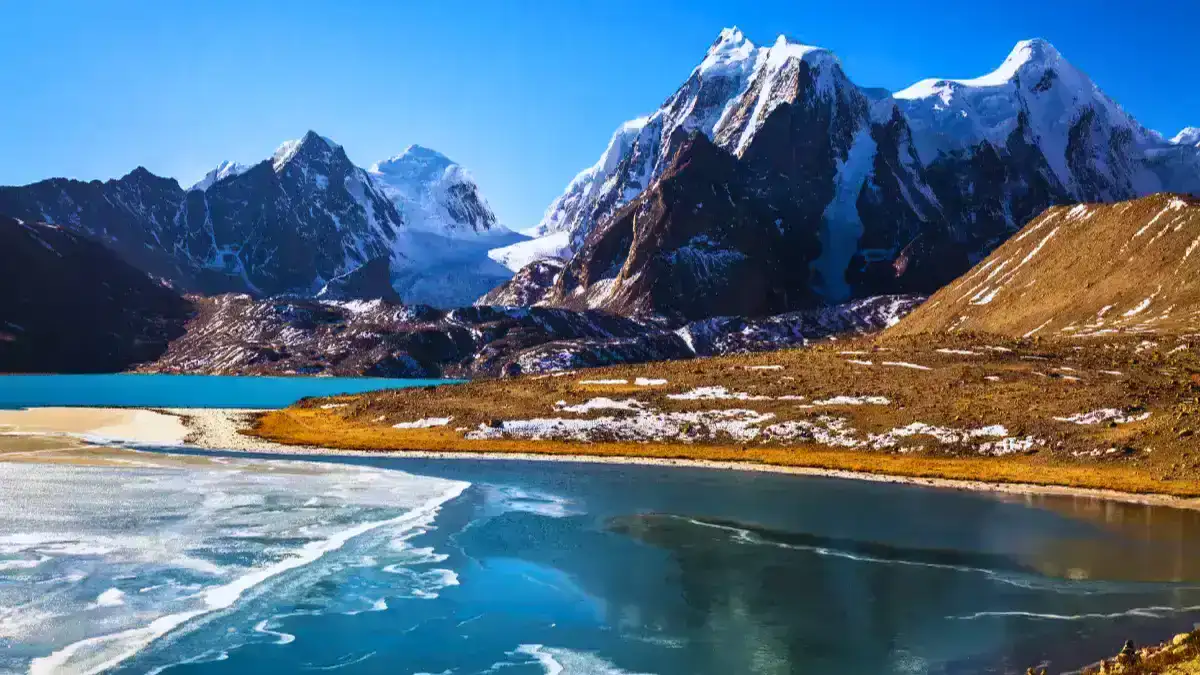
Gurudongmar Lake is one of the highest freshwater lakes present in the world. The lake is situated at a height of 5430 meters above sea level. Every year many riders and tourists visit this location from different parts of India to witness the breathtaking site and rejuvenate themselves.
Gurudongmar Lake Travel Tips
If you are a person with high altitude sickness, then you must arrange for the necessary medications as well as arrange for portable oxygen to avoid health issues due to lack of oxygen. You will also need to acquire special permits to visit the Gurudongmar lake which can be collected either online or offline.
Gurudongmar Lake Facts
As per the locals, this lake has been blessed by Guru Padmasambhava, during his journey to Tibet. It is also a pilgrimage site that is visited every year by both Hindus and Buddhists. At times, the temperature also drops below -20 degrees Celsius, which makes the lake freeze.
Main Highlights
- The best time to visit Gurudongmar Lake is between April and May.
- It is also considered a sacred place by Hindus, Sikhs, and Buddhists.
| Place Name | Type | Distance from Gurudongmar Lake (in km) |
| Zero Point | Point of Interest | 165 |
| Dongkha La | Point of Interest | 14.6 |
| Chombu | Point of Interest | 32.3 |
| Yumesamdong | Point of Interest | 143 |
Pal Karma Zurmang Shedup Chokhor Ling Lingdum Monastery
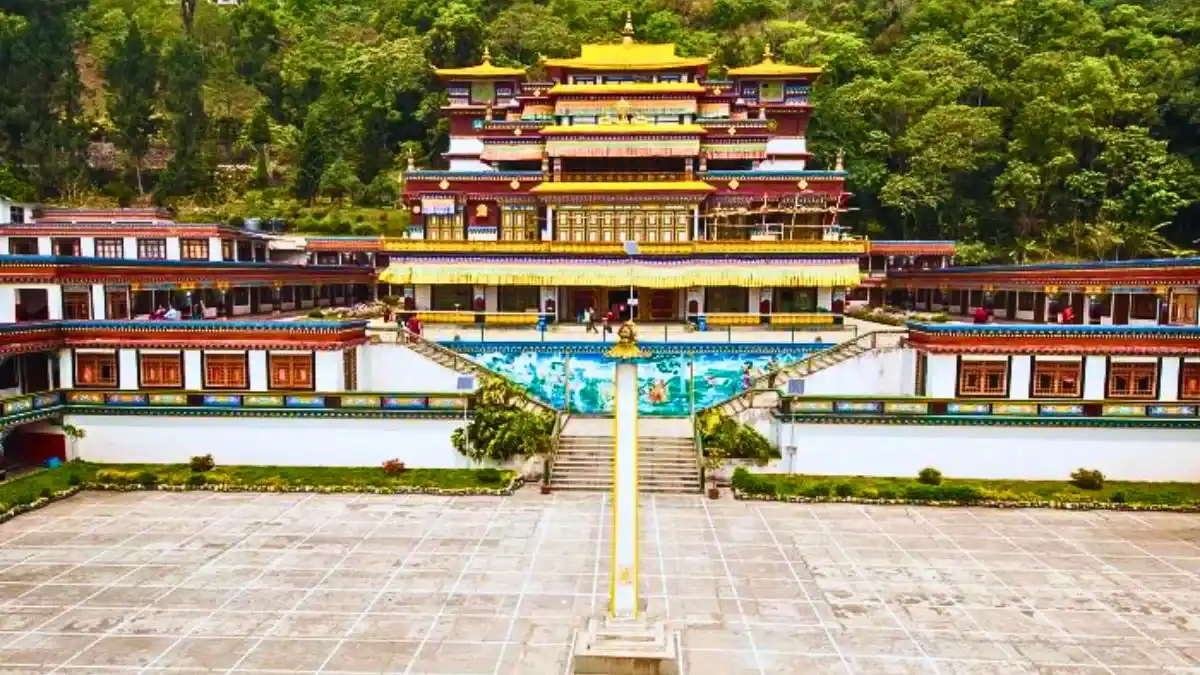
Pal Karma Zurmang Shedup Chokhor Ling Lingdum Monastery in short is called Lingdum monastery, which is located in the village of Lingdum which is located in the East Sikkim. It is a Buddhist monastery that was completed in the year 1999 and acknowledges the Zurmang Kagyu culture of Tibetan Buddhism. The monastery offers breathtaking views of snow-capped mountains, forests, and valleys.
Pal Karma Zurmang Shedup Chokhor Ling Lingdum Monastery Travel Tips
If you are planning to visit Lingdum Monastery, then you must visit during the months of March to May (Spring) and between September and October (Autumn). There are options for taking a taxi or jeep from Gangtok to Ranka, which is at a distance of 16.9 km and may take around 50 minutes to reach the destination.
Pal Karma Zurmang Shedup Chokhor Ling Lingdum Monastery Facts
The monastery houses a large Buddha statue along with different meditation halls and chapels. The monastery was built by Zurmang Gharwang Rinpoche, who is the 12th successive incarnation of Zurmang Gharwang of the Kagyupa Sect.
Main Highlights
- Lingdum monastery was built in Tibetan architectural style and stands of great importance to people as a place of worship.
- The monastery took a period of 7 years to complete as the construction work began in the year 1992.
| Place Name | Type | Distance from Pal Karma Zurmang Shedup Chokhor Ling Lingdum Monastery (in km) |
| Ban Jhakri Waterfalls | Waterfalls | 8.1 |
| Do Drul Chorten | Religious Place | 15.4 |
| Enchey Monastery | Religious Place | 17.5 |
| Ganesh Tok | Religious Place | 20.0 |
| Hanuman Tok | Religious Place | 23.6 |
| Gangtok Ropeway | Point of Interest | 14.8 |
Frequently Asked Questions
Which is the most beautiful part of Sikkim?
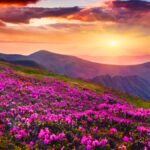
Yumthang Valley, located in North Sikkim, is a stunning destination known for its diverse flora and fauna, particularly the rhododendrons, making it a paradise for nature lovers.
How many places are there in Sikkim to visit?
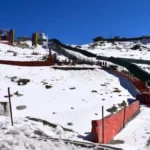
There are numerous places around Sikkim to be visited, some of them are, Tsomgo Lake, Nathula Pass, Yuksom, Lachung, Lachen, Yumthang Valley, Teesta River, Ravangla, Pelling, Zuluk, Namchi, Khangchendzonga National Park Rumtek Monastery and many more.
Is 3 days enough for Sikkim?

Despite the numerous tourist destinations in Sikkim, a few days in North Sikkim are suitable for exploring Gangtok, Nathu La, Nathula Pass, Rumtek, and Enchey monasteries.
Which is better Sikkim or Darjeeling?

Sikkim, with its cleanliness and affordable prices, attracts tourists for its Buddhist, Nepali, and Tibetan culture and architecture, while Darjeeling offers cheaper food, lodging, and travel.
Which month is snowfall in Sikkim?
The winter months of late November through February are the greatest times to visit Sikkim to see snowfall. During these months, Gangtok, Yumthang Valley, Lachung, and Pelling are a few locations in Sikkim where you might encounter snowfall, with temperatures ranging from -5 to 7 degrees Celsius.
How to reach Sikkim by flight?

You can travel to Sikkim by flight by flying from Kolkata or Delhi to Pakyong airport which is situated at a distance of 2.3 km from the main town of Pakyong and will take around 8 minutes to reach. If the flights are unavailable, you can also fly to Bagdogra International Airport (IXB), as it connects both national and international flights.
Which is the coldest month in Sikkim?
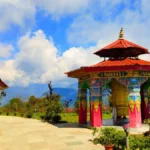
In Sikkim, the cold season lasts from October to February. The winter season officially starts at the end of December and ends in January, which is the coldest month of the year.

